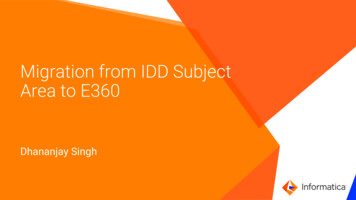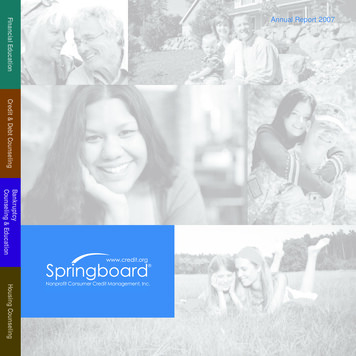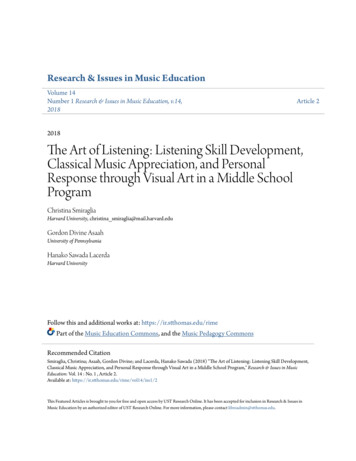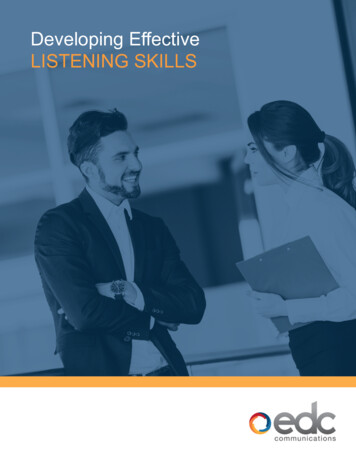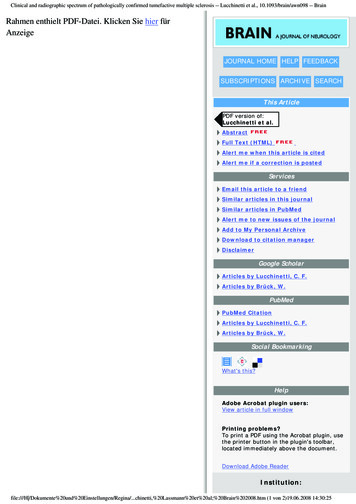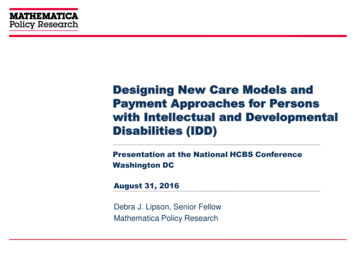
Transcription
LISTENING SESSIONS – PROJECT GUIDEIDD Diversity & Inclusion Task ForceWhat is a Listening Session?A Listening Session is similar to a ‘focus group’ in marketing/business. Participants in a Listening Sessionare asked to talk about their experiences and sometimes answer specific questions about a topic.Generally, the goal is to understand the opportunities and challenges surrounding a topic as familiesthemselves perceive them. As providers, we use the information participants share to determine whatchanges or actions we need to take. In a health care system where families often have limited means togive feedback, Listening Sessions are a tool to collect valuable information on the patient experience!Logistics: Listening Sessions typically last between an hour to an hour and a half Groups of 5-8 participants are ideal, ensuring everyone has time to talk Participants should have personal or first-hand experience with the topic of discussion Organizers should consider: family transportation, childcare and/or work schedules whendetermining the time/location to make it as convenient as possible Facilitators should be skilled in validating and redirecting participantsHELPFUL RESOURCES:Start here Waisman Center “Launching Inclusive Efforts through Community Conversations”Georgetown Center for Cultural and Linguistic CompetenceInstitute for Patient and Family Centered Care“Listening Sessions” folder on the Task Force boxEstablish the purpose of your Listening Session:Participants must be invested in the topic of your Listening Session if they are going to show up and givehonest feedback. Consider how your topic/goal is motivating and meaningful for families. Tips: keep it simple (what’s your one main goal), emphasize the change you hope to create,make it have a direct impact on kids, offer an incentive (item, skill, or resource)Conduct informational interviews with key stakeholders:Unless you already have significant experience with your target group, a helpful first-step is talking torepresentatives of the community. Cultural brokers, family representatives, etc. will have ideas aboutwhat to incorporate, where/when to hold your session, and how to motivate participants to attend.Members of the Task Force who have experience with Listening Sessions:Daria Ettinger (Research Associate, IDD) Conducted focus groups on clinic space for “Life Span” clinics, wrote up the results for the Deanof the School of MedicineShauna Signorini & Tamara Bakewell (Oregon Family to Family Health Information Center) Conduct Listening Sessions with Family to Family participants yearlyPaulina Larenas (LEND Trainee, FACT Oregon) Worked with Daria, and Breanne/Hannah to lead Listening Sessions in Spanish for IDD/CDRC,has extensive experience facilitating parent groups through her work with FACT OregonCompiled by Breanne Toney M.S., CF-SLP – Last Revised 8/10/2018
Lindsay Sauvé (Research Associate, UCEDD) Helped analyze and present data from previous UCEDD Listening Sessions in rural communities.Identify your target participants:The way you recruit will depend on the target audience and scope of your Listening Session. The less PHIyou have to collect from participants, the more likely your project will be “Quality Improvement.” If youneed to contact/recruit specific participants, you will likely need IRB oversight. You will need a clear ideaof your recruitment method before you submit your IRB application.Possible methods of recruitment: Pass out fliers to participants of a specific clinic (more specific group) Post fliers in the IDD/CDRC and/or specific community centers/locations (more general group) Partner with a non-profit or other group that will ‘recruit’ for you (some ideas below)o Oregon Family 2 Family Health Information Networko FACT Oregono OHSU Patient and Family Advisorso United Cerebral Palsy of Oregono Autism Society of Oregono Northwest Down Syndrome AssociationSubmit a “Request for Determination”:Your Listening Session may qualify as a Quality Improvement project, which does not need IRB oversight.To determine if you qualify for this status, you’ll need to summarize the intent of your Listening Session(goals, questions, recruitment, data collection, publication) in a Request for Determination form. Tips: for quality improvement, avoid collection of PHI. It’s ok to audio record data/dialogue thatdoesn’t include participant names or PHI. If you plan to publish your research later, it may be better to have IRB oversight as most researchjournals will require this for publication.Complete an Information Sheet/Consent to Participate Form:If project is Quality Improvement, the Information Sheet summarizes your study and is a tool forparticipants if they have questions or want to contact you after the Listening Session. If you have IRBoversight, the Consent Form will be part of your IRB proposal, and will take time to complete duringyour Listening Session.Advertising:Access the pre-designed OHSU templates for rack cards, trifold brochures and fliers on the TemplatePortal (O2 Communications Templates, Logos and More). You can save your completed templates asPDF files or submit them for printing. Tips: If you’re partnering with a non-profit or other group, ask if they can post/send-out yourflier, or otherwise recruit participants (Facebook groups, emails, etc.). Your community stakeholders will also have ideas about advertising.Plan your Listening Session:See the sample outline for a 90 minute Listening Session in the resources below. Introduction: set the purpose of your session, review the IRB information sheet and logisticsCompiled by Breanne Toney M.S., CF-SLP – Last Revised 8/10/2018
Discussion: consider how much time you’ll need for your particular mix of open-endedquestions, directed questions, activities, etc.o If you expect a comfortable/talkative group, starting with a positively-framed openended question may be best.o If you expect you’ll need to ‘get people talking’ consider opening with an activity ormore directed/specific questions that set the stage for the dialogue you hope to have.Facilitator tips: your facilitator will need to be skilled at verbally summarizing, validating, and redirecting participants. Before you begin, consider addressing the time limitations, and warnparticipants that you may need to redirect the dialogue to make sure all topics are addressed(see “Tips for Facilitators” handout below)Conclusion: Leave 5-10 minutes at the end of the session to summarize input, review next-stepsand remind participants how their valuable input will be used!Make Sure to Bring:-Copies of the Information Sheet or Consent Forms-At least 2 audio recording devices (check these work before you go)-Paper/pens or a laptop to take notes (also back-up if recording fails)-Donations (food, beverages, etc.) if applicableSet yourself up for easy data analysis: Recording: as noted above, consider using multiple audio-recorders so you have back-up. In thespace, determine the best placement (away from windows/fans/background noise) and/or testyour recorder beforehand. The clearer the recording quality, the easier transcription will be. Note-Taking: determine a note-taker (or two), other than the facilitator who will attend theListening Session. It is helpful to write the first word or line of each participant turn so you canclearly delineate speakers when you transcribe. Transcription: As a rule of thumb, it will take around an hour to transcribe every 20 minutes ofthe Listening Session. This will likely take longer if you need to transcribe and translate intoanother language, so plan accordingly.Distribution:How you choose to distribute your results will vary depending on your scope/topic. Regardless, you willlikely need to share and summarize what you learned. Food for thought: consider including complete quotes/talk-points in the participants own words(and/or with accompanying translation) so that their perspectives and sentiments are minimallyaltered. Example Summaries: in the “Listening Session” folder on box, you can find example summariesfrom previous UCEDD and task-force listening sessions. Screenshots in the resources below.Compiled by Breanne Toney M.S., CF-SLP – Last Revised 8/10/2018
SAMPLE TIMELINESEPT-OCT:Research Listening SessionsDetermine a topic/theme for your sessionTalk to key stakeholdersIdentify possible groups for recruitmentNOV-DEC:Outline your plan in a “Request for Determination” (If determined to be Quality Improvement, this willturn-around 2 weeks)Create your Information Sheet or Consent for Participation formJAN:Reach-out to prospective groups to see if they are interested in hostingAnd/or finalize your recruitment/advertising planFEB-MAR:Determine/finalize the date/locationCreate a flier on the OHSU marketing portal to advertise your event (if needed)Disseminate your flier or begin other advertisingAPRIL:Reach out to local grocery stores with at least 30 days notice to request a donation of food/beveragesDepending on the event, you may also request donations of clothing, toys or booksArrange for access/use of recording devices, if neededMAY:Finalize your event outline (see sample)If you are doing guided activities (butcher paper/post-it notes), written surveys, etc. assemble materialsas neededConduct your Listening Session!JUNE-JULY:Thank your recruitment partners/participantsTranscribe data, and code for themes as determined in your research protocolAUG:Compile your findings into a summary (info-graphic, PPT presentation, report, one-pager, etc.)Present your findings to the Task ForceShare any resources created in the “Listening Session” folder on box.Compiled by Breanne Toney M.S., CF-SLP – Last Revised 8/10/2018
Compiled by Breanne Toney M.S., CF-SLP – Last Revised 8/10/2018
Compiled by Breanne Toney M.S., CF-SLP – Last Revised 8/10/2018
SAMPLE OUTLINECompiled by Breanne Toney M.S., CF-SLP – Last Revised 8/10/2018
TIPS FOR FACILITATORS:Author: Paulina Larenas (IDD Task Force/FACT Oregon)Introductions: Introduce yourself and give time for other team members to introduce themselves Ask families to introduce themselves (according to demographic information in your IRBproposal) Consider asking something fun about them (e.g., what did they do earlier that day?). Explain the difference between the CDRC, OHSU or Doernbecher if relevant for your topic. Introduce the project: Why are we doing this? What’s the outcome? What will you talk about? If the session will be audio-recorded, let families know. Explain names will not be recorded norpersonal information disclosed. Start audio-recording after the family introductions. Consider setting some agreements/group norms before the session begins. Check for questions or concerns before you start.During the session: There will be times you need to take initiative, sometimes families are not sure what toanswer or what the questions is about. If this is the case, try a short personal example.o After this, consider asking person by person around the group. Be confident and redirect as needed (it’s easy for discussion to get out of track).o Say something like “yes, thank you so much for sharing that, does anyone have anexperience about.? (repeat the question)” Interrupt only when necessary or if someone is taking too much time sharing. You can saysomething like, “I am sorry about your experience ” and then redirect to someone else. Smile throughout the session. Try not to take up much time sharing your experiences, only if itis necessary to redirect or guide the conversation. A little bit of humor is always good, it makes the participants feel more comfortable and tendsto ease the tension. If some families are not talking, encourage them to talk by asking more specific questions, orby looking to them and saying something like “what about your experience.” Be respectful, remember that families are talking about their children and lived experiences.This can be uncomfortable with strangers, difficult to share, and emotional for them. Families need to feel safe, especially in the current political climate. Repeat/assure them theirinformation will be kept confidential. Remain positive at all times, even if the conversation starts to turn negative. Validate andacknowledge negative experiences, but try to help them see the positives.End of the session: Thank everyone for participating! Make sure families know how important and valuabletheir time is, especially to the team holding the Listening Session Ask if they have any questions or feedback they can give about the Listening Sessionexperience.Compiled by Breanne Toney M.S., CF-SLP – Last Revised 8/10/2018
SAMPLE ABSTRACT:Compiled by Breanne Toney M.S., CF-SLP – Last Revised 8/10/2018
SAMPLE SUMMARY (partial)Compiled by Breanne Toney M.S., CF-SLP – Last Revised 8/10/2018
SAMPLE SUMMARY (partial)Compiled by Breanne Toney M.S., CF-SLP – Last Revised 8/10/2018
SAMPLE PPT SLIDES (partial)Compiled by Breanne Toney M.S., CF-SLP – Last Revised 8/10/2018
what to incorporate, where/when to hold your session, and how to motivate participants to attend. Members of the Task Force who have experience with Listening Sessions: Daria Ettinger (Research Associate, IDD) Conducted focus groups on clinic space for Life Span _ clinics, wrote up the results for the Dean of the School of Medicine

